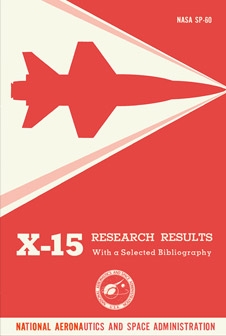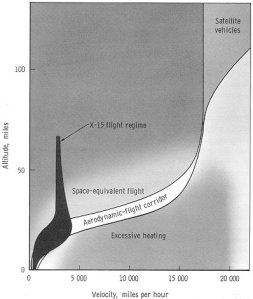Continuing with the reviews of the NASA aeronautics free ebook series (1), now is the turn of “X-15 Research Results” by Wendell H. Stillwell, one of the two ebooks devoted to this incredible record breaking research aircraft, the other book being “X-15 Extending the Frontiers of Flight”.
The first thing that caught my attention about this book, compared to the other titles of the series, is that it is in fact a release from 1964, then commemorating 10 years of the inception of the X-15 research program. It thus provides a glimpse into the breakthrough technologies of the aircraft through the eyes, and with the knowledge, of that time. I have had fun reading the many comments from the author regarding the perspectives of the “future” use of the technologies present in the X-15 for the then upcoming space race!
In its around 100 pages, the book reviews rather the technical aspects of the research program, giving account in the main seven chapters of the concept development, research objectives, aerodynamic aspects of the hypersonic flight, structural aspects, dynamics of flight and man-machine interface. It includes a log of the main flights, but it doesn´t review the contractual set-up, the management or other organizational aspects of the program as did the other books of the series that I read so far.
Now allow me to go through some of my takeaways of the mentioned main sections:
Concept and flight research aspects
The program goal was a general one aimed at preparing the orbital flight, which in the 50s definitely was an endeavour needed of research, as I already mentioned. The aircraft would serve as a research tool with rather “live” design objectives instead of trying to optimize one unique design. Following conditions marked the corridor where the X-15 would fly to gain data:
At the time of the inception of the program, the “sound barrier” was known (since the Bell X-1 in fact already overcome) but the next challenge in the range of speeds of the X-15 flight corridor would be the thermal barrier, a leapfrog challenge, as it turned out. Preliminary studies from 1954 and on would show that speeds of Mach 8 to 10 were not attainable with the technology of that era. Then, the general goal would be to fly as fast as Mach 6 at around 250.000ft. This would lead to a set of conditions and aircraft features to deal with them. The ones that most caught my attention were:
- Need of a rocket engine. Developed by Thiokol, the XLR-99 would deliver throttlelable 250kN thrust. The propellants, a mix including LOx, needed to be stored at ultra low temperatures inside the aircraft.
- Temperatures at the nose, leading edge and other elements of up to 1200ºF (or 650ºC) when flying at max speed led to select Inconel-X material for the skins. A manufacturing challenge, and also a design one given the difference between outside temperature and that of the tanks for the propellants!
- Flight controls, including three control sticks: the traditional in the middle, an additional side one for the pilot to operate with the arm fixed to the side at high g conditions, and finally one for the booster controls at the peak altitude where the aerodynamic of the control surfaces was less effective.
- A jettisonable lower vertical tail surface, extending the upper one for enhance stability at the high speed conditions of the reentry phase, but to be detached for landing.
- Heavy FTI was needed onboard for a pure research aircraft. Many probes had to pass through the stiff Inconel skin. That was also a challlenge and some of them were not as reliable as in normal aircraft with the specific high atmosphere conditions in the flight corridor.
These features are described in the first chapters along with an account of the operations of a total of 120 flights in 5 years. It is describre how extensive use of the simulator was made, not without problems (2), along with use of the “centrifuge” from Navy to allow pilots to experience high-g conditions on ground. The launch operation from a modified B-52 wing and the typical flight paths around Edwards AF Base are commented as well.
Hypersonic conditions
The book goes further on with an explanation of the hypersonic flight characteristics. From a review of the thermal aspects that need to be taken into account (in contrast to near sonic conditions, where they are negligible) to the calculation and testing challenges that these speeds imposed to the program.
For instance, at the beginning the shockwaves were calculated separatedly for the body and the other elements and control surfaces, and then interactions were studied to infere the global flowfield. However, it turned out to be difficult to replicate calculation results in the wind tunnel testing due to the high non-linearity of this type of airflow.
At that time no much theoretical progress was achieved, but the testing helped set up an ample empirical database which proved useful for the later study based on modern computer fluid dynamics (CFD) in the decades after the X-15 program was terminated.
The thermal challenge, where i.e the temperature at Mach 6 would be 8x the one present at Mach 3, was worsened by the turbulent flow in some flight phases, imposing strong oscillations in the skin temperature, reaching finally up to 1500ºF. It was nearly impossible to simulate that conditions in the wind tunnels at that time, making it difficult to develop solutions for the heat management, both for surfaces and structure.
Flight dynamics and man machine interface
The remarkable variations in the flight dynamics among the different phases of a single research flight of the X-15 was another engineering challenge to be solved. It led to the development of the first concepts moving away from mechanical to electrical steering of control surfaces, and to the introduction of adaptative gains of these controls (which would open the era of the modern flight control systems discussed in other books of the NASA series).
Even with advanced flight controls for that era, the pilots were faced with conditions they had seldom experienced before. At that point, the phyisiological research of flight was not nearly as evolved as the technology present in the airframe and systems, that had been continously developed since the Wright Brothers. Then, the X-15 program was a breakthrough in terms of monitoring the conditions in which pilots performed, i.e. tracking parameters such as skin temperature, oxigen flow, electrocardiograph or suit pressure.
Some words be written to the pressure suit, which was a major development itself. It was needed to secure vital oxygen supply for the pilot when over 100.000 ft the cockpit pressure was almost lost. It´s design evolved to incorporate other supplies, including the physiological monitoring, it laid the foundation for the modern anti-g suits and the concept was reused for the later Mercury and Gemini space programs.
In summary, you will discover in the book an introductory review of the many innovations and breakthroughs that accompained this program, with the historical taste of a text writen half a century ago that will delight the aviation geeks.
A recommended rearding to all aviation enthusiasts with interest in the evolution of the technology.
Finally, take a look a these two pictures of the X-15 in flight and at landing:
————–
(1) Find the links for the other reviews: X-29 with forward swept wings (here), F-18 with active aeroelastic wings (here), 9 case studies with mishaps (here).
(2) Simulation could not prevent that under increased workload, a trained pilot suffered the amiguitiy of the display panel, which was found to be a contributing factor to one fatal accident of the X-15, as reviewed in the ebook devoted to mishaps of the NASA series.






Pingback: Thinking obliquely – book review | jaimeirastorza
Pingback: NASA Aeronautical ebooks – An Overview | jaimeirastorza
Pingback: Probing the Sky – book review | jaimeirastorza